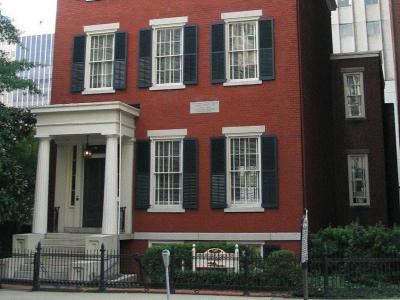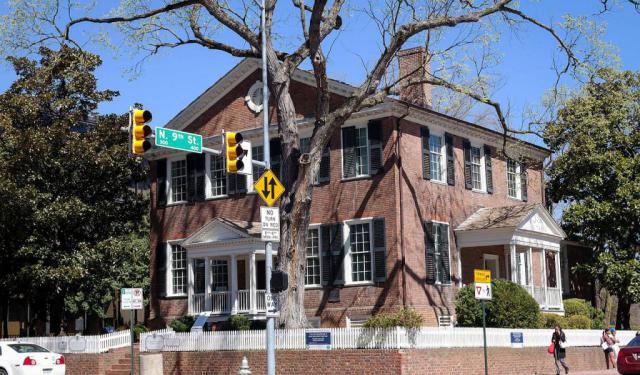Stewart–Lee House, Richmond
The Stewart-Lee House, also known as the Norman Stewart House, is a significant historical site located in Richmond. Constructed in 1844 by Norman Stewart, a wealthy Scottish tobacco merchant, this residence is an exemplary model of the Greek Revival architectural style prevalent during that era. The three-story, brick townhouse is distinguished by its three-bay structure and low-hipped roof, which is complemented by four interior end chimneys and a simple molded cornice with a plain frieze.
The Stewart-Lee House, once part of "Stewart’s Row," is the only remaining building from the original five constructed by Stewart. Known for its shoebox shape and efficient use of space, its historical significance is enhanced by its connection to General Robert E. Lee. After losing their Arlington property in 1864, Lee's wife and daughter moved into the house. Lee himself briefly resided there from April to June 1865, after surrendering at Appomattox, leaving due to the disturbance from continuous visitors. The house underwent various uses through the late 19th and 20th centuries, was donated to the Virginia Historical Society in 1893, and transferred to the Confederate Memorial Literary Society in 1961. It was recognized on the National Register of Historic Places in 1972 for its historical and architectural value.
Today, the building’s surroundings have dramatically changed, now juxtaposed against modern structures like a fifteen-story office building and surrounded by a parking lot. Despite these changes, features such as a Greek-fret patterned cast-iron fence and a small portico preserve its historical essence. The house underwent extensive renovations in 2001 led by the Home Builders Association of Virginia, which currently uses the building as offices. These renovations have played a crucial role in preserving the architectural dignity and historical narrative of the Stewart-Lee House, allowing it to stand as a testament to Richmond's rich past amidst its modern landscape.
The Stewart-Lee House, once part of "Stewart’s Row," is the only remaining building from the original five constructed by Stewart. Known for its shoebox shape and efficient use of space, its historical significance is enhanced by its connection to General Robert E. Lee. After losing their Arlington property in 1864, Lee's wife and daughter moved into the house. Lee himself briefly resided there from April to June 1865, after surrendering at Appomattox, leaving due to the disturbance from continuous visitors. The house underwent various uses through the late 19th and 20th centuries, was donated to the Virginia Historical Society in 1893, and transferred to the Confederate Memorial Literary Society in 1961. It was recognized on the National Register of Historic Places in 1972 for its historical and architectural value.
Today, the building’s surroundings have dramatically changed, now juxtaposed against modern structures like a fifteen-story office building and surrounded by a parking lot. Despite these changes, features such as a Greek-fret patterned cast-iron fence and a small portico preserve its historical essence. The house underwent extensive renovations in 2001 led by the Home Builders Association of Virginia, which currently uses the building as offices. These renovations have played a crucial role in preserving the architectural dignity and historical narrative of the Stewart-Lee House, allowing it to stand as a testament to Richmond's rich past amidst its modern landscape.
Want to visit this sight? Check out these Self-Guided Walking Tours in Richmond. Alternatively, you can download the mobile app "GPSmyCity: Walks in 1K+ Cities" from Apple App Store or Google Play Store. The app turns your mobile device to a personal tour guide and it works offline, so no data plan is needed when traveling abroad.
Stewart–Lee House on Map
Sight Name: Stewart–Lee House
Sight Location: Richmond, USA (See walking tours in Richmond)
Sight Type: Attraction/Landmark
Guide(s) Containing This Sight:
Sight Location: Richmond, USA (See walking tours in Richmond)
Sight Type: Attraction/Landmark
Guide(s) Containing This Sight:
Walking Tours in Richmond, Virginia
Create Your Own Walk in Richmond
Creating your own self-guided walk in Richmond is easy and fun. Choose the city attractions that you want to see and a walk route map will be created just for you. You can even set your hotel as the start point of the walk.
Richmond Introduction Walking Tour
After settling Jamestown in 1607, several expeditions up the James River led to an interest in the area inhabited by the Powhatan Nation. But the first European settlements didn’t come for more than a hundred years when in 1737, planter William Byrd II had the original town grid laid out.
He named the town “Richmond” after an English town. He felt the view of the James River was similar... view more
Tour Duration: 2 Hour(s)
Travel Distance: 3.7 Km or 2.3 Miles
He named the town “Richmond” after an English town. He felt the view of the James River was similar... view more
Tour Duration: 2 Hour(s)
Travel Distance: 3.7 Km or 2.3 Miles
Historical Homes Walking Tour
Being one of America’s oldest major cities, the capital of Virginia, Richmond, is rich with historic homes, dating back well into the 1800s and beyond. Those passionate about storied buildings will surely find plenty to their taste here.
The Edgar Allan Poe Museum, The White House of the Confederacy – home of Confederate President Jefferson Davis during the Civil War, and the John Marshall... view more
Tour Duration: 2 Hour(s)
Travel Distance: 3.1 Km or 1.9 Miles
The Edgar Allan Poe Museum, The White House of the Confederacy – home of Confederate President Jefferson Davis during the Civil War, and the John Marshall... view more
Tour Duration: 2 Hour(s)
Travel Distance: 3.1 Km or 1.9 Miles
Maymont and Carytown Walking Tour
Maymont, a picturesque and spacious Victorian estate in Richmond, Virginia, is a popular outdoor attraction nestled in the very heart of the city.
Home to the beautifully landscaped Japanese and Italian gardens surrounding the opulent, historic Maymont Mansion, it represents a remnant from America's Gilded Age. Nature enthusiasts can also explore the Maymont Wildlife Center, home to... view more
Tour Duration: 2 Hour(s)
Travel Distance: 4.0 Km or 2.5 Miles
Home to the beautifully landscaped Japanese and Italian gardens surrounding the opulent, historic Maymont Mansion, it represents a remnant from America's Gilded Age. Nature enthusiasts can also explore the Maymont Wildlife Center, home to... view more
Tour Duration: 2 Hour(s)
Travel Distance: 4.0 Km or 2.5 Miles






